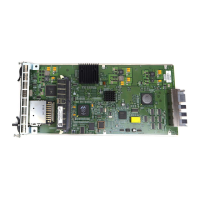182 Brocade MLXe Series Hardware Installation Guide
53-1003030-01
Using alarms to collect and monitor device status
5
• Critical - A condition that will cause damage to the system. A condition that causes a traffic
outage on multiple ports.
• Major - A condition that causes traffic outage on single ports or might cause damage to the
system.
• Minor - A condition that should be investigated but will not damage the system.
By default, all hardware status alarm levels of major severity and higher are logged, though you can
configure the status alarm levels sent to both alarm logs (current and history). You can use the
show alarm command to view the current status on a device, or a logged history of hardware
alarms. To change the levels of alarms sent to the alarm logs, refer to “Configuring Alarm History
Buffer Size” on page 182.
The alarms are specific to hardware status, whereas the syslog records information for software
events. Alarms can also be configured on very specific terms such as a failed temperature sensor
on a single interface module.
To take advantage of this feature, you should first set the alarm history buffer size. This is optional,
but you have the option to limit how many entries are stored in the alarm history so you can free up
space for other resources. Refer to “Configuring Alarm History Buffer Size” on page 182 for more
information.
Next, you should configure the severity of alarms for each device you want logged. For detailed
information, refer to “Configuring alarm logging” on page 182. Once you have configured your
alarm logging, you can display alarms in the current alarm log and alarm history log using the show
alarm command, as described in Table 39 on page 184.
Configuring Alarm History Buffer Size
The history buffer size is configurable. The default buffer size is 400 entries, but it can be
configured to list between 100 and 3000 entries using the alarm history command.
For example, to configure the alarm history log size to 100 entries, enter the following command:
Brocade# alarm history 100
Syntax: [no] alarm history n
where n is the number of log entries you want to store in the alarm history log, between 100 and
3000.
To reset the alarm history back to the default buffer size, use the alarm history command with the
no operand. For example, to set the buffer size back to the default entry size from 100, enter the
following command:
Brocade# no alarm history 100
Configuring alarm logging
You can configure the system to log only specific level alarms for specific devices using the alarm
command. The configuration setting applies to both logs, the current and history alarm logs. The
level you set is the minimum level of alarms that will be logged. For example, if you set the
configuration to log a minimum of minor level events, all minor, major and critical events will be
logged. If you set the configuration to log a minimum of major level events, all major and critical
events will be logged. If you set the configuration to log a minimum of critical level events, only
critical level events will be logged.

